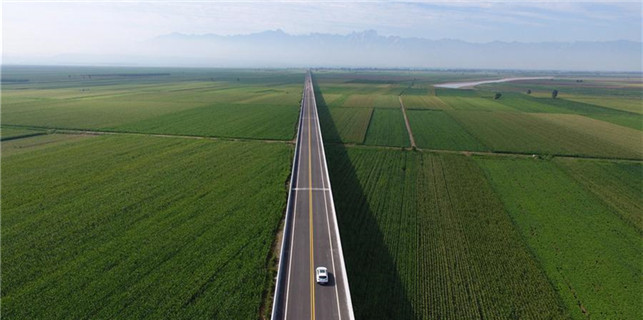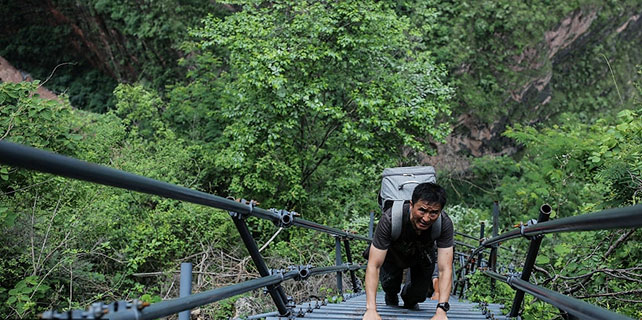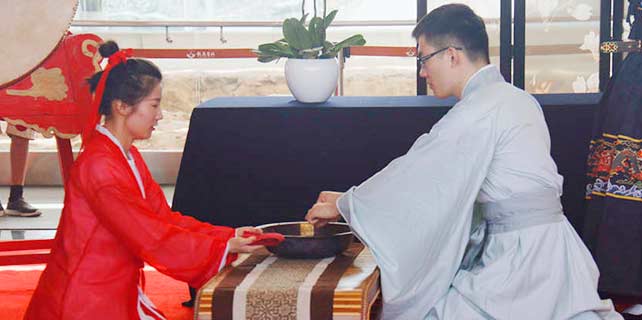Controversial chimney stokes industrial heritage debate
Plans to lower a 180-meter-high smokestack in Beijing's downtown have sparked calls for a reprieve, as Yuan Quan and Wang Fei report for Xinhua China Features.
The controversy has raged for nine years, but now it seems the fate of a landmark Beijing building has been sealed.
A 180-meter-high chimney, dubbed "the most obtrusive building on the West Second Ring Road", will be transformed into a spacious observation deck - standing just 8 meters above ground level.
The chimney, in Xicheng district, was built in 1976 for the Beijing No 2 Thermal Power Plant, which was shut down and relocated to the suburbs in 2009 to reduce air pollution.
Since then, the site has been redeveloped as a cultural and artistic district, similar to the popular 798 Art Zone.
Wang Wu, director of the renovation project, said the plan to reduce the height of the chimney, drawn up by a team from the Architectural Design and Research Institute at Tsinghua University, was delivered to the Beijing planning department last month.
"Once approved, the project will begin," Wang said.
Before the 2008 Olympic Games, Beijing cracked down on pollution and dismantled chimneys that emitted noxious particles into the atmosphere.
However, the highest chimney in the downtown area remained, fueling heated public debate over its fate.
Experts said the debate is a sign of great progress, indicating a growing awareness of historic buildings, and the government is now more cautious when it comes to city planning.
Cultural eyesore
Supporters of the project argue that the chimney is in the "wrong place" and a blot on the surrounding cityscape and other iconic buildings.
The smokestack is just 92 meters from the Tianning Pagoda, Beijing's oldest surviving religious edifice, built 898 years ago during the Liao Dynasty (916-1125).
The 58-meter-high pagoda is located in the Tianning Temple, which was destroyed during a war about 700 years ago, but rebuilt during the late Ming Dynasty (1368-1644).
Known for its beautiful chrysanthemum garden, the temple attracted crowds of worshippers and visitors before the founding of the People's Republic of China in 1949.
"The chimney does not respect nearby cultural relics," said Huo Chunlong, chief designer of the renovation plan.
"The law that protects cultural relics prohibits taller facilities within 1 kilometer of historic sites, let alone within 100 meters."
To preserve the city's skyline, the Beijing government implemented height restrictions of 30 meters in the 1980s.
"The factory was built during the 'cultural Revolution' (1966-76), when people had little awareness of cultural heritage," said Yang Zhenhua, a former city planning adviser.
The power plant was built in 1976 to supply heat and electricity to an area of 520,000 square meters in the city center - including Zhongnanhai (the headquarters of the Communist Party of China), the Great Hall of the People and the Diaoyutai State Guesthouse. It is just 5 kilometers from Tian'anmen Square.
"In the 1970s, there were no homes around the temple, just cornfields. So, maybe the pagoda was the only thing that was not considered," said Shen Lanhai, 60, a senior engineer who was involved in the construction of the power plant.
A forest of chimneys was then regarded as a symbol of modernization. Chairman Mao Zedong once said, "Looking out from Tian'anmen, I should see chimneys everywhere."
In the 1980s, more than 14,000 industrial smokestacks were visible in Beijing. At the time, industrial output accounted for 63.7 percent of the capital's GDP and air pollution was severe.
Reminder of a bygone age
In 1983, the central government ordered Beijing, the capital for more than 850 years, to become "a political and cultural center" and to "no longer develop heavy industry".
For this reason, some scholars suggest the chimney should be retained as a reminder of a bygone age.
"The chimney and the pagoda have coexisted for 40 years, and the two buildings together have become new historic relics," said Zhao Zhongshu, a senior engineer at the China Academy of Urban Planning and Design. "Understanding of architectural heritage is constantly developing and enriched. I don't agree that the chimney should be dismantled. It should be protected as industrial heritage."
Opponents dispute the concept of "industrial heritage".
The chimney is only 40 years old and has no special value or features compared with other chimneys, according to Zhu Zuxi, vice-director of the Beijing Geographic Society.
"It is a total failure of Beijing's protection of cultural relics and of city planning. The nightmare of the Tianning Pagoda should end," Zhu said.
Chen Ying, a former worker at the power plant, said the city should be proud of the chimney.
The 43-year-old said the power plant was the first in Beijing to be equipped with fuel-burning boilers, which were highly efficient and relatively clean for their time.
"The chimney was built so high specifically to protect residents from the emissions," she said.
Chen recalled how she and a few colleagues climbed on the 36-meter-high boiler houses every two hours during winter to ensure the machinery was working correctly: "We worked hard, but we were very proud, because our work made the city warm and bright."
It has been the only chimney in downtown Beijing since 2008. "Why not keep one chimney to mark the past?" she said.
Last year, more than 60 percent of 700 respondents to an online poll were in favor of preserving the chimney.
"That's why we plan to lower it to 8 meters. It will preserve the skyline and a piece of history," Huo, the renovation plan's chief designer, said.
New uses
In March last year, the power plant and the Beijing government organized an architectural competition to redevelop the chimney. The competition received about 51 suggestions in two months.
The oldest entrant was age 86, while the youngest was a middle school student.
Wang, the project's director, was impressed by a suggestion to decorate the chimney with a huge LED screen that would broadcast real-time air quality data.
"It would be very eye-catching, environmentally friendly and affordable," Wang said.
Chen hopes to see a "less industrial" use for the chimney, and jokingly suggested that it should include a platform for sky diving or bungee jumping.
The protection of historic relics has been a key concern for the central government since 2012, and President Xi Jinping has ordered authorities at all levels to strengthen protection and promote appropriate and moderate use of relics.
The Beijing government has yet to issue a final decision, but the question of the chimney's possible demolition was included in a July graduation test for junior high school students in the city.
Ma Ying, a professor at Beijing University of Civil Engineering and Architecture, said the debate illustrates how "city planning is not just a top-down decision-making process, but also needs advice and supervision from the bottom up".
The Tour Montparnasse in Paris, which was completed in 1973, was also criticized for destroying the French capital's historic skyline, according to Ma.
"Why not keep the chimney and let the debate continue as a caution against repeating the same mistake?" Ma said.
(China Daily 08/30/2017 page6)






















